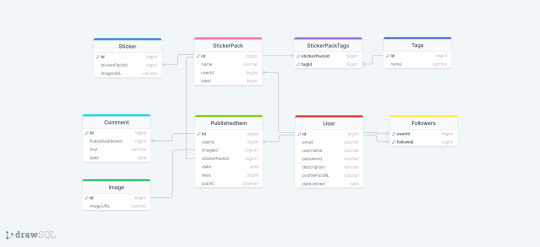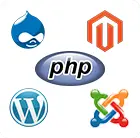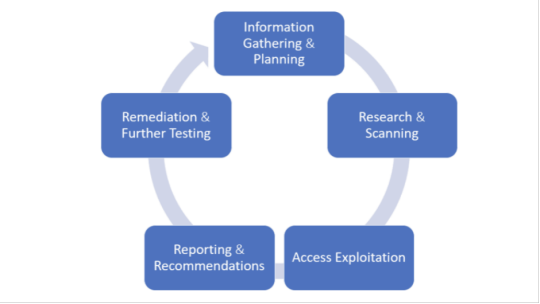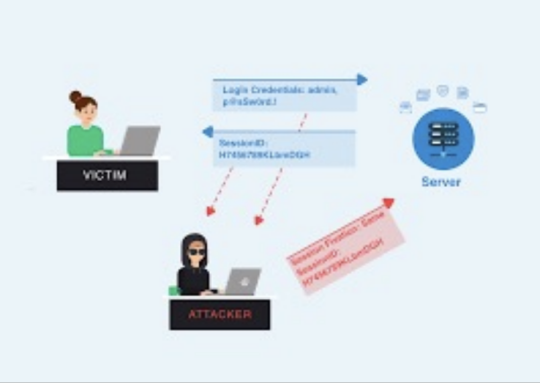#SQL SERVER Online Test Question
Explore tagged Tumblr posts
Text
Backend update
Had the most horrible time working with Sequelize today! As I usually do whenever I work with Sequelize! Sequelize is an SQL ORM - instead of writing raw SQL, ORM gives you an option to code it in a way that looks much more like an OOP, which is arguably simpler if you are used to programming that way. So to explain my project a little bit, it's a full stack web app - an online photo editor for dragging and dropping stickers onto canvas/picture. Here is the diagram.

I'm doing it with Next which I've never used before, I only did vanilla js, React and a lil bit of Angular before. The architecture of a next project immediately messed me up so much, it's way different from the ones I've used before and I often got lost in the folders and where to put stuff properly (this is a huge thing to me because I always want it to be organized by the industry standard and I had no reference Next projects from any previous jobs/college so it got really overwhelming really soon :/) . The next problem was setting up my MySQL database with Sequelize because I know from my past experience that Sequelize is very sensitive to where you position certain files/functions and in which order are they. I made all the models (Sequelize equivalent of tables) and when it was time to sync, it would sync only two models out of nine. I figured it was because the other ones weren't called anywhere. Btw a fun fact

So I imported them to my index.js file I made in my database folder. It was reporting an db.define() is not a function error now. That was weird because it didn't report that for the first two tables that went through. To make a really long story short - because I was used to an server/client architecture, I didn't properly run the index.js file, but just did an "npm run dev" and was counting on all of the files to run in an order I am used to, that was not the case tho. After about an hour, I figured I just needed to run index.js solo first. The only reasons those first two tables went through in the beginning is because of the test api calls I made to them in a separate file :I I cannot wait to finish this project, it is for my bachelors thesis or whatever it's called...wish me luck to finish this by 1.9. XD
Also if you have any questions about any of the technologies I used here, feel free to message me c: <3 Bye!
#codeblr#code#programming#webdevelopment#mysql#nextjs#sequelize#full stack web development#fullstackdeveloper#student#computer science#women in stem#backend#studyblr
15 notes
·
View notes
Text
How To Get An Online Internship In the IT Sector (Skills And Tips)

Internships provide invaluable opportunities to gain practical skills, build professional networks, and get your foot in the door with top tech companies.
With remote tech internships exploding in IT, online internships are now more accessible than ever. Whether a college student or career changer seeking hands-on IT experience, virtual internships allow you to work from anywhere.
However, competition can be fierce, and simply applying is often insufficient. Follow this comprehensive guide to develop the right technical abilities.
After reading this, you can effectively showcase your potential, and maximize your chances of securing a remote tech internship.
Understand In-Demand IT Skills
The first step is gaining a solid grasp of the most in-demand technical and soft skills. While specific requirements vary by company and role, these competencies form a strong foundation:
Technical Skills:
Proficiency in programming languages like Python, JavaScript, Java, and C++
Experience with front-end frameworks like React, Angular, and Vue.js
Back-end development skills - APIs, microservices, SQL databases Cloud platforms such as AWS, Azure, Google Cloud
IT infrastructure skills - servers, networks, security
Data science abilities like SQL, R, Python
Web development and design
Mobile app development - Android, iOS, hybrid
Soft Skills:
Communication and collaboration
Analytical thinking and problem-solving
Leadership and teamwork
Creativity and innovation
Fast learning ability
Detail and deadline-oriented
Flexibility and adaptability
Obtain Relevant Credentials
While hands-on skills hold more weight, relevant academic credentials and professional IT certifications can strengthen your profile. Consider pursuing:
Bachelor’s degree in Computer Science, IT, or related engineering fields
Internship-specific courses teaching technical and soft skills
Certificates like CompTIA, AWS, Cisco, Microsoft, Google, etc.
Accredited boot camp programs focusing on applied skills
MOOCs to build expertise in trending technologies like AI/ML, cybersecurity
Open source contributions on GitHub to demonstrate coding skills
The right credentials display a work ethic and supplement practical abilities gained through projects.
Build An Impressive Project Portfolio
Nothing showcases skills better than real-world examples of your work. Develop a portfolio of strong coding, design, and analytical projects related to your target internship field.
Mobile apps - publish on app stores or use GitHub project pages
Websites - deploy online via hosting services
Data science - showcase Jupyter notebooks, visualizations
Open source code - contribute to public projects on GitHub
Technical writing - blog posts explaining key concepts
Automation and scripts - record demo videos
Choose projects demonstrating both breadth and depth. Align them to skills required for your desired internship roles.
Master Technical Interview Skills
IT internship interviews often include challenging technical questions and assessments. Be prepared to:
Explain your code and projects clearly. Review them beforehand.
Discuss concepts related to key technologies on your resume. Ramp up on fundamentals.
Solve coding challenges focused on algorithms, data structures, etc. Practice online judges like LeetCode.
Address system design and analytical problems. Read case interview guides.
Show communication and collaboration skills through pair programming tests.
Ask smart, well-researched questions about the company’s tech stack, projects, etc.
Schedule dedicated time for technical interview practice daily. Learn to think aloud while coding and get feedback from peers.
Show Passion and Curiosity
Beyond raw skills, demonstrating genuine passion and curiosity for technology goes a long way.
Take online courses and certifications beyond the college curriculum
Build side projects and engage in hackathons for self-learning
Stay updated on industry news, trends, and innovations
Be active on forums like StackOverflow to exchange knowledge
Attend tech events and conferences
Participate in groups like coding clubs and prior internship programs
Follow tech leaders on social mediaListen to tech podcasts while commuting
Show interest in the company’s mission, products, and culture
This passion shines through in interviews and applications, distinguishing you from other candidates.
Promote Your Personal Brand
In the digital age, your online presence and personal brand are make-or-break. Craft a strong brand image across:
LinkedIn profile - showcase achievements, skills, recommendations
GitHub - displays coding activity and quality through clean repositories
Portfolio website - highlight projects and share valuable content
Social media - post career updates and useful insights, but avoid oversharing
Blogs/videos - demonstrate communication abilities and thought leadership
Online communities - actively engage and build relationships
Ensure your profiles are professional and consistent. Let your technical abilities and potential speak for themselves.
Optimize Your Internship Applications
Applying isn’t enough. You must optimize your internship applications to get a reply:
Ensure you apply to openings that strongly match your profile Customize your resume and cover letters using keywords in the job description
Speak to skills gained from coursework, online learning, and personal projects
Quantify achievements rather than just listing responsibilities
Emphasize passion for technology and fast learning abilities
Ask insightful questions that show business understanding
Follow up respectfully if you don’t hear back in 1-2 weeks
Show interest in full-time conversion early and often
Apply early since competitive openings close quickly
Leverage referrals from your network if possible
This is how you do apply meaningfully. If you want a good internship, focus on the quality of applications. The hard work will pay off.
Succeed in Your Remote Internship
The hard work pays off when you secure that long-awaited internship! Continue standing out through the actual internship by:
Over Communicating in remote settings - proactively collaborate
Asking smart questions and owning your learning
Finding mentors and building connections remotely
Absorbing constructive criticism with maturity
Shipping quality work on or before deadlines
Clarifying expectations frequently
Going above and beyond prescribed responsibilities sometimes
Getting regular feedback and asking for more work
Leaving with letters of recommendation and job referrals
When you follow these tips, you are sure to succeed in your remote internship. Remember, soft skills can get you long ahead in the company, sometimes core skills can’t.
Conclusion
With careful preparation, tenacity, and a passion for technology, you will be able to get internships jobs in USA that suit your needs in the thriving IT sector.
Use this guide to build the right skills, create an impressive personal brand, ace the applications, and excel in your internship.
Additionally, you can browse some good job portals. For instance, GrandSiren can help you get remote tech internships. The portal has the best internship jobs in India and USA you’ll find. The investment will pay dividends throughout your career in this digital age. Wishing you the best of luck! Let me know in the comments about your internship hunt journey.
#itjobs#internship opportunities#internships#interns#entryleveljobs#gradsiren#opportunities#jobsearch#careeropportunities#jobseekers#ineffable interns#jobs#employment#career
4 notes
·
View notes
Text
How To Get An Online Internship In the IT Sector (Skills And Tips)

Internships provide invaluable opportunities to gain practical skills, build professional networks, and get your foot in the door with top tech companies.
With remote tech internships exploding in IT, online internships are now more accessible than ever. Whether a college student or career changer seeking hands-on IT experience, virtual internships allow you to work from anywhere.
However, competition can be fierce, and simply applying is often insufficient. Follow this comprehensive guide to develop the right technical abilities.
After reading this, you can effectively showcase your potential, and maximize your chances of securing a remote tech internship.
Understand In-Demand IT Skills
The first step is gaining a solid grasp of the most in-demand technical and soft skills. While specific requirements vary by company and role, these competencies form a strong foundation:
Technical Skills:
>> Proficiency in programming languages like Python, JavaScript, Java, and C++ >> Experience with front-end frameworks like React, Angular, and Vue.js >> Back-end development skills - APIs, microservices, SQL databases >> Cloud platforms such as AWS, Azure, Google Cloud >> IT infrastructure skills - servers, networks, security >> Data science abilities like SQL, R, Python >> Web development and design >> Mobile app development - Android, iOS, hybrid
Soft Skills:
>> Communication and collaboration >> Analytical thinking and problem-solving >> Leadership and teamwork >> Creativity and innovation >> Fast learning ability >> Detail and deadline-oriented >> Flexibility and adaptability
Obtain Relevant Credentials
While hands-on skills hold more weight, relevant academic credentials and professional IT certifications can strengthen your profile. Consider pursuing:
>> Bachelor’s degree in Computer Science, IT, or related engineering fields. >> Internship-specific courses teaching technical and soft skills. >> Certificates like CompTIA, AWS, Cisco, Microsoft, Google, etc. >> Accredited boot camp programs focusing on applied skills. >> MOOCs to build expertise in trending technologies like AI/ML, cybersecurity. >> Open source contributions on GitHub to demonstrate coding skills.
The right credentials display a work ethic and supplement practical abilities gained through projects.
Build An Impressive Project Portfolio
Nothing showcases skills better than real-world examples of your work. Develop a portfolio of strong coding, design, and analytical projects related to your target internship field.
>> Mobile apps - publish on app stores or use GitHub project pages >> Websites - deploy online via hosting services >> Data science - showcase Jupyter notebooks, visualizations >> Open source code - contribute to public projects on GitHub >> Technical writing - blog posts explaining key concepts >> Automation and scripts - record demo videos
Choose projects demonstrating both breadth and depth. Align them to skills required for your desired internship roles.
Master Technical Interview Skills
IT internship interviews often include challenging technical questions and assessments. Be prepared to:
>> Explain your code and projects clearly. Review them beforehand. >> Discuss concepts related to key technologies on your resume. Ramp up on fundamentals. >> Solve coding challenges focused on algorithms, data structures, etc. Practice online judges like LeetCode. >> Address system design and analytical problems. Read case interview guides. >> Show communication and collaboration skills through pair programming tests. >> Ask smart, well-researched questions about the company’s tech stack, projects, etc.
Schedule dedicated time for technical interview practice daily. Learn to think aloud while coding and get feedback from peers.
Show Passion and Curiosity
Beyond raw skills, demonstrating genuine passion and curiosity for technology goes a long way.
>> Take online courses and certifications beyond the college curriculum >> Build side projects and engage in hackathons for self-learning >> Stay updated on industry news, trends, and innovations >> Be active on forums like StackOverflow to exchange knowledge >> Attend tech events and conferences >> Participate in groups like coding clubs and prior internship programs >> Follow tech leaders on social media >> Listen to tech podcasts while commuting >> Show interest in the company’s mission, products, and culture
This passion shines through in interviews and applications, distinguishing you from other candidates.
Promote Your Personal Brand
In the digital age, your online presence and personal brand are make-or-break. Craft a strong brand image across:
>> LinkedIn profile - showcase achievements, skills, recommendations >> GitHub - displays coding activity and quality through clean repositories >> Portfolio website - highlight projects and share valuable content >> Social media - post career updates and useful insights, but avoid oversharing >> Blogs/videos - demonstrate communication abilities and thought leadership >> Online communities - actively engage and build relationships
Ensure your profiles are professional and consistent. Let your technical abilities and potential speak for themselves.
Optimize Your Internship Applications
Applying isn’t enough. You must optimize your internship applications to get a reply:
>> Ensure you apply to openings that strongly match your profile >> Customize your resume and cover letters using keywords in the job description >> Speak to skills gained from coursework, online learning, and personal projects >> Quantify achievements rather than just listing responsibilities >> Emphasize passion for technology and fast learning abilities >> Ask insightful questions that show business understanding >> Follow up respectfully if you don’t hear back in 1-2 weeks >> Show interest in full-time conversion early and often >> Apply early since competitive openings close quickly >> Leverage referrals from your network if possible
This is how you do apply meaningfully. If you want a good internship, focus on the quality of applications. The hard work will pay off.
Succeed in Your Remote Internship
The hard work pays off when you secure that long-awaited internship! Continue standing out through the actual internship by:
>> Over Communicating in remote settings - proactively collaborate >> Asking smart questions and owning your learning >> Finding mentors and building connections remotely >> Absorbing constructive criticism with maturity >> Shipping quality work on or before deadlines >> Clarifying expectations frequently >> Going above and beyond prescribed responsibilities sometimes >> Getting regular feedback and asking for more work >> Leaving with letters of recommendation and job referrals
When you follow these tips, you are sure to succeed in your remote internship. Remember, soft skills can get you long ahead in the company, sometimes core skills can’t.
Conclusion
With careful preparation, tenacity, and a passion for technology, you will be able to get internships jobs in USA that suit your needs in the thriving IT sector.
Use this guide to build the right skills, create an impressive personal brand, ace the applications, and excel in your internship.
Additionally, you can browse some good job portals. For instance, GrandSiren can help you get remote tech internships. The portal has the best internship jobs in India and USA you’ll find.
The investment will pay dividends throughout your career in this digital age. Wishing you the best of luck! Let me know in the comments about your internship hunt journey.
#internship#internshipopportunity#it job opportunities#it jobs#IT internships#jobseekers#jobsearch#entryleveljobs#employment#gradsiren#graduation#computer science#technology#engineering#innovation#information technology#remote jobs#remote work#IT Remote jobs
5 notes
·
View notes
Text
Boost Your Database Certification Prep with Real Practice Tests!
Are you preparing for top database certifications like Oracle, IBM, or Microsoft SQL Server? Don’t just read — practice like it’s the real exam! 🧠
🌐 DBExam.com offers trusted, up-to-date online practice exams for a wide range of database certifications. Whether you're aiming for Oracle OCA, IBM DB2, or MySQL certifications, you'll find:
✅ Realistic exam questions ✅ Instant result reports ✅ Unlimited practice access ✅ Proven success rate with global professionals
💡 Why Choose DBExam? Because it’s not just about passing — it’s about mastering your skills and getting career-ready in a competitive tech world.
📚 Start practicing smart. Pass with confidence. 👉 Visit www.dbexam.com now.
1 note
·
View note
Text
Why PHP Development Companies Still Lead in Web App Development

In the rapidly changing digital landscape, web application technologies evolve at lightning speed. Yet, the demand for a PHP development company has not only remained steady—it has grown. As businesses seek scalable, secure, and efficient web applications, PHP continues to be a go-to language, supported by a vast community and a proven track record. The rise of cloud-native apps and digital transformation projects have only strengthened PHP’s relevance.
Hiring a PHP development company in 2025 means working with experts who understand the legacy of PHP while leveraging its modern frameworks like Laravel and Symfony. These frameworks make development faster, cleaner, and more secure. Moreover, PHP powers over 77% of websites with server-side programming, including giants like Facebook and WordPress. So, why fix something that clearly isn’t broken?
What’s even more compelling is PHP’s low barrier to entry, wide pool of skilled developers, and cost-efficiency. A PHP development company often delivers projects at a fraction of the cost compared to companies working with newer or more niche technologies. This affordability doesn’t mean compromising quality; it reflects the maturity of the platform and the abundance of available tools and talent.
PHP Development: Is Still Worth it in 2025? Absolutely. PHP has evolved drastically, with PHP 8+ introducing JIT compilation and substantial performance boosts. This makes web apps faster and more capable. When you engage a PHP development company, you're not just hiring coders; you're partnering with professionals who use a battle-tested language backed by decades of improvements and community contributions.
Furthermore, PHP’s compatibility with various platforms and hosting services makes it a versatile choice. A reputable PHP development company ensures seamless integration of PHP-based applications with MySQL, PostgreSQL, and even cloud services like AWS and Azure. This makes it ideal for startups and enterprises alike looking for flexibility and scalability.
The industry today is flooded with tech stacks—Node.js, Python, Ruby, Java, and more. However, few have PHP's balance of performance, simplicity, and support. That’s why many of the Top PHP Web Development Companies remain at the forefront of digital solutions. These firms combine PHP's robust capabilities with innovative front-end frameworks to build dynamic, user-friendly applications.
A PHP development company also offers extensive CMS and eCommerce solutions. Platforms like Magento, Drupal, and Joomla rely heavily on PHP. Customizing or extending these platforms requires PHP proficiency. Thus, businesses seeking tailored solutions for online stores or content-rich sites often find PHP development teams indispensable.
Security is another reason why businesses prefer a PHP development company. While no language is immune to vulnerabilities, PHP has matured significantly. Modern PHP frameworks offer built-in protection against common threats like SQL injection, cross-site scripting (XSS), and cross-site request forgery (CSRF). Moreover, these frameworks follow MVC architecture, which inherently promotes secure and clean coding practices.
Many companies still face the classic question: Which is Best for Web Development – PHP vs Python? The answer depends on project scope and goals. PHP excels in web-centric development with hundreds of pre-built modules and libraries. Python, while versatile, is often more suited to data science, machine learning, and scripting. However, when it comes to pure web development, a PHP development company offers better speed-to-market and lower overhead.
A reliable PHP development company also understands the importance of responsive design and performance optimization. Whether your audience accesses your app via mobile or desktop, PHP apps can be optimized using modern tools like caching mechanisms, CDN integration, and performance tuning, ensuring users have a seamless experience.
What differentiates the best firms from the rest is their ability to offer tailored, scalable, and secure solutions. A custom software development company specializing in PHP often blends industry knowledge with technical expertise to create platforms that are both user-centric and future-ready. Whether it's a customer portal, booking system, or CRM, PHP remains a powerful engine under the hood.
With open-source support and a mature ecosystem, PHP continues to outpace many newer languages in real-world implementation. Businesses turn to a PHP development company because they know it guarantees reliability and speed without excessive overhead. Additionally, PHP's long-standing presence ensures stability—there's little risk of the language becoming obsolete anytime soon.
Even in 2025, PHP isn’t just surviving—it’s thriving. With thousands of new developers entering the field each year, PHP remains one of the most taught and used languages globally. When you hire a PHP development company, you're investing in a stable technology that offers long-term value and continuous innovation.
So, why do companies keep choosing PHP over other technologies? It boils down to three things: speed, scalability, and support. A modern PHP development company leverages tools like Laravel, CodeIgniter, and CakePHP to cut down on development time while increasing application robustness. These companies often maintain dedicated QA teams and DevOps integration to ensure smoother project delivery.
Despite the arrival of countless JavaScript-based frameworks and back-end alternatives, PHP has adapted without losing its core strengths. A PHP development company in 2025 doesn’t look like the PHP shops of 2010—they’re more agile, cloud-integrated, and aligned with DevSecOps and CI/CD pipelines. This evolution reflects PHP’s resilience and adaptability.
In conclusion, if you're planning your next web application, don't overlook the advantages of partnering with a trusted PHP development company. Whether you're a startup aiming for rapid deployment or an enterprise seeking system modernization, PHP provides a cost-effective and high-performance solution. With features tailored for modern web demands, experienced developer communities, and proven scalability, PHP continues to be a strategic asset in web app development.
0 notes
Text
How to Become a Software Engineer: A Full Guide

Software engineering is a rewarding and in-demand career that involves designing, developing, testing, and maintaining software systems. Whether you're a fresh graduate or looking for a career change, this guide will provide you with a roadmap to becoming a software engineer.
1. Foundational Knowledge
A strong foundation is crucial for any aspiring software engineer. Here's what you need to focus on:
Programming Fundamentals: Start with a beginner-friendly language like Python, JavaScript, or Java. Understand the basic concepts such as variables, data types, control structures, and object-oriented programming (OOP).
Data Structures and Algorithms: Learn how data is organized and manipulated. This includes arrays, linked lists, trees, graphs, and common algorithms like sorting and searching.
Operating Systems: Gain a basic understanding of how operating systems work, including memory management, processes, and file systems.
Databases: Learn how to design and manage databases using SQL or NoSQL.
Version Control: Familiarize yourself with Git for tracking changes in your code and collaborating with others.
2. Choose Your Path
Software engineering offers various specializations. Here are a few popular ones:
Web Development:
Frontend: Focuses on the user interface and user experience using HTML, CSS, and JavaScript frameworks like React or Angular.
Backend: Focuses on server-side logic, databases, and APIs using languages like Python, Java, or Node.js.
Full-Stack: Works on both frontend and backend development.
Mobile App Development: Develop applications for mobile devices using languages like Swift (iOS) or Java/Kotlin (Android).
Data Science: Focuses on extracting insights from data using statistical analysis, machine learning, and programming languages like Python or R.
Machine Learning: Develop algorithms and models that enable computers to learn from data.
3. Education and Learning Resources
Formal Education: A bachelor's degree in computer science or software engineering provides a comprehensive foundation.
Online Courses and Bootcamps: Platforms like Coursera, Udacity, edX, and freeCodeCamp offer structured learning paths and certifications.
Self-Learning: Utilize books, tutorials, and documentation to learn at your own pace.
4. Build Projects
Practical experience is essential for becoming a software engineer.
Personal Projects: Create your own applications or websites to showcase your skills.
Open Source Contributions: Contribute to existing projects on platforms like GitHub to collaborate with other developers and gain real-world experience.
Internships: Seek internships to gain professional experience and learn from industry experts.
5. Build a Portfolio
A portfolio is a collection of your projects and accomplishments that demonstrates your skills to potential employers.
Showcase Your Best Work: Include a variety of projects that highlight your technical abilities and problem-solving skills.
Provide Context: For each project, explain the problem you solved, the technologies you used, and the outcome.
Use a Professional Platform: Create a website or use platforms like GitHub Pages to host your portfolio.
6. Networking and Job Search
Networking: Attend industry events, join online communities, and connect with other software engineers on LinkedIn.
Job Search: Utilize online job boards, company websites, and networking to find job opportunities.
Interview Preparation: Practice coding challenges, review data structures and algorithms, and prepare for behavioral questions.
7. Continuous Learning
The field of software engineering is constantly evolving, so continuous learning is crucial.
Stay Updated: Follow industry blogs, attend conferences, and learn new technologies.
Explore New Areas: Be open to learning new programming languages, frameworks, and tools.
Seek Mentorship: Find a mentor who can provide guidance and support throughout your career.
Becoming a software engineer requires dedication, perseverance, and a passion for learning. By following this guide and continuously building your skills and knowledge, you can embark on a successful career in this dynamic and rewarding field.
0 notes
Text
Boost Your Web Development Skills: Akhilagna’s Key Learning Resources
In the ever-evolving world of web development, staying ahead requires continuous learning and the ability to adapt to new tools, technologies, and methodologies. Whether you're an aspiring developer or a seasoned professional, accessing quality resources can make all the difference in boosting your skills. At Akhilagna IT, we understand the significance of empowering developers with the right learning tools and resources. This article highlights some of the key learning resources we offer to help you thrive in your web development journey.
Comprehensive Online Tutorials
Akhilagna’s curated online tutorials are designed to cater to developers at various skill levels. From foundational concepts like HTML, CSS, and JavaScript to advanced topics such as frameworks, libraries, and backend development, our tutorials provide step-by-step guidance. Each tutorial is enriched with real-world examples, ensuring that learners can directly apply what they learn in practical scenarios.
For beginners, we cover essentials like:
Structuring web pages with HTML
Styling elements using CSS
Interactive user interfaces with JavaScript
For advanced developers, topics include:
Working with modern frameworks like React, Angular, and Vue.js
Server-side programming with Node.js and Django
Managing databases using MongoDB and SQL
Interactive Coding Challenges
Learning by doing is one of the most effective ways to develop technical skills. Our platform offers interactive coding challenges that allow you to test your knowledge and sharpen your problem-solving abilities. These challenges are tailored to simulate real-world development tasks, such as debugging code, optimizing performance, and creating scalable web solutions.
Expert-Led Webinars and Workshops
At Akhilagna, we believe in the power of live learning experiences. Our expert-led webinars and workshops provide opportunities to learn from industry professionals who share their insights, experiences, and best practices. Topics range from the basics of responsive design to mastering cloud integration and DevOps practices.
Workshops often include hands-on projects, allowing participants to apply their skills under the guidance of experienced mentors. These sessions also provide a platform to ask questions, seek feedback, and interact with peers in the development community.
Resourceful Blogs and Articles
Our blog section is a treasure trove of articles covering a wide array of web development topics. Whether you're looking to understand the latest trends, explore in-depth tutorials, or discover tips for career growth, our blogs cater to diverse interests and needs. Written by experts, these articles provide actionable insights that can help you stay updated in this fast-paced field.
Project-Based Learning Opportunities
Akhilagna emphasizes the importance of project-based learning to bridge the gap between theory and practice. By working on real-world projects, developers can gain hands-on experience, build their portfolios, and develop a deeper understanding of web development concepts. These projects span areas like e-commerce site creation, API development, and single-page application (SPA) design.
Community Support and Collaboration
Becoming part of a supportive community can significantly enhance your learning experience. Akhilagna’s developer community offers a collaborative space where members can share ideas, seek advice, and discuss the latest trends in web development. Through forums, group projects, and networking events, developers can connect with like-minded professionals and expand their horizons.
Conclusion
In the dynamic landscape of web development, continuous learning is not just an option but a necessity. Akhilagna IT is dedicated to equipping developers with the knowledge, skills, and tools they need to excel. By leveraging our tutorials, coding challenges, webinars, and other resources, you can stay ahead in your career and tackle complex development challenges with confidence. Explore Akhilagnait Services offerings today and take the next step in your web development journey!
0 notes
Text
ASP.Net Development | ASP.Net Develoment Company

Need a strong, adaptable, and reliable platform to carry your company into the next phase of growth and success? Microsoft created the open source ASP.NET (Active Server Pages.NET) framework primarily to aid programmers in creating dynamic, reactive, and responsive web pages and apps. When it comes to software design and development, there is no tool as strong or versatile as ASP.NET. You can create an unbeatable combo that is scalable, safe, and strong enough to be paired with SQL Server on the back end!
Blue Summit is an ASP.NET development company that combines technical expertise with practical business knowledge to create and implement successful web applications. We combine a lightweight UI framework with Microsoft.NET and SQL Server to give users of the application, a distinctive experience.
Why We Standout?
Performance and quality have been the main drivers of our success as an ASP.NET development firm. We have worked on a number of new product development projects using the .Net framework that effectively crossed industry verticals. .Net-based porting projects that were completed by our teams add to our portfolio of accomplishments. In accordance with your needs, we provide different options for hiring ASP.NET professionals. Hiring ASP.NET web developers will allow you to grow your company without incurring additional expenditures while creating specialized corporate solutions. Our team of skilled and knowledgeable ASP.NET programmers unleash one-of-a-kind, specially designed solutions that guarantee customers' commercial progress.
The following are some grounds for you to consider using our exceptional ASP.NET development services:
A team with an average experience of 8+ years that is productive, proven, and result-oriented.
Concentrate on producing enterprise-grade apps of the finest quality.
Using the most up-to-date equipment/technologies and software engineering best practices.
A cost-effective worldwide development and delivery methodology.
Concentrate on providing software that is of high-quality, high- performing, and secure.
A track record of delivering all C#/.Net projects prior to the deadline.
Committed technical support for all ASP.NET components and versions.
Our ASP.Net Development, Desktop and Mobile Applications Development Services
Our ASP.NET experts work in the following fields:

Server scripting, ASP.NET MVC.
CMS, CRM and OMS.
Development of website forms.
HTML, DHTML, ASP.NET Ajax, CSS.
Continuous support for JavaScript, C++, and C#.
ASP.NET-based custom web application development.
E-commerce and Shopping Cart development.
Third Party Tools.
20 languages for ASP.NET coding, including C, Visual Basic, and JavaScript.
Using web server controls like RSS feeds, XML, and XSL.
We can also migrate your applications from any obsolete legacy version to the latest one.
QA testing for your ASP.NET application
Blue Summit's ASP.Net Developers
Our team of skilled and proficient ASP.NET developers has a proven track record of delivering exceptional results for our clients. With their expertise in creating bespoke, interactive, and high-quality web, desktop, and cloud-based applications, our ASP.NET programmers are committed to enhancing your company's online presence with scalable and high-performing software solutions. Trust our team to deliver software that adds value to your business.
Our Development Process
01
Understanding Requirement
We assign a exclusive team to work with you and understand all the concepts and requirements of your project.
02
User Interface Design
At Blue Summit, user needs come first and our products follow industry UX design standards.
03
Software Architecture
While Agile questions upfront analysis, some solution architecture is necessary for effectiveness.
04
Implementation
Upon obtaining design approval, we build the product according to the client's requirements.
05
Deployment
After rigorous testing and QA, our experts will launch your product on app stores and web browsers. Get ready to see your masterpiece live!
06
Support
We regularly monitor and maintain the application and environment to ensure proper functionality.
#ASP.NET Development#ASP.Net Develoment Company#ASP.NET developers#ASP.NET application#ASP.NET programmers
0 notes
Text
Hello Coding - Anyone Can Learn to Code! 550+ Hours of Content!

"Hello Coding: Anyone Can Learn to Code!" is an expansive online course designed to introduce and deepen understanding of computer programming for individuals at all skill levels. With over 550 hours of meticulously curated content, the course aims to transform beginners into proficient coders and to help experienced programmers refine and expand their skills.
Course Structure and Content
The course is structured to cover a broad range of programming topics and languages. Starting from the basics, it gradually progresses to more complex concepts, ensuring that learners build a solid foundation before tackling advanced subjects. Key areas covered include web development, mobile app development, data science, and game development, among others.
Introduction to Programming: The course begins with an introduction to programming fundamentals. It covers the basic principles of coding, such as variables, control structures, functions, and data types. This section is designed to be accessible to complete novices, with no prior experience required.
Web Development: This segment delves into HTML, CSS, and JavaScript, teaching learners how to create and style web pages. It also covers popular frameworks and libraries like React, Angular, and Vue.js, which are essential for modern front-end development. On the back-end side, it explores server-side languages like Node.js, Python, and PHP, along with databases such as SQL and MongoDB.
Mobile App Development: Learners are introduced to mobile app development for both Android and iOS platforms. The course covers native app development using Swift for iOS and Kotlin for Android. It also explores cross-platform development frameworks like Flutter and React Native, which allow developers to create apps that work on multiple operating systems from a single codebase.
Data Science and Machine Learning: For those interested in data science, the course offers comprehensive modules on Python, R, and various data analysis libraries and tools. It covers data visualization, statistical analysis, and machine learning algorithms. This section is ideal for learners who wish to pursue careers in data science or integrate data-driven decision-making into their existing skill set. You can also try this HELLO CODING
Game Development: The course includes modules on game development using popular engines like Unity and Unreal Engine. It covers the basics of game design, programming, and the creation of both 2D and 3D games. This segment is particularly appealing to creative individuals who want to bring their game ideas to life.
Learning Approach
"Hello Coding" adopts a project-based learning approach. This means that instead of just theoretical learning, students engage in hands-on projects that allow them to apply what they have learned. These projects range from simple exercises to complex applications, ensuring that learners can see the real-world applications of their coding skills.
The course also emphasizes interactive learning. Through coding challenges, quizzes, and peer interactions, learners are encouraged to test their knowledge and learn from others. This interactive environment helps to reinforce learning and fosters a sense of community among participants.
Support and Resources
Learners have access to a wealth of resources to support their learning journey. These include detailed video tutorials, comprehensive reading materials, and practical coding exercises. Additionally, the course provides access to mentors and instructors who can offer guidance and answer questions.
Career Preparation
One of the standout features of "Hello Coding" is its focus on career preparation. The course includes modules on resume building, portfolio development, and interview preparation. This ensures that learners are not only equipped with technical skills but are also prepared to enter the job market with confidence.
Conclusion you can also try this HELLO CODING
"Hello Coding: Anyone Can Learn to Code!" is an all-encompassing course that caters to a wide audience, from complete beginners to experienced developers. Its extensive content, project-based approach, and focus on career preparation make it an invaluable resource for anyone looking to start or advance their coding journey. With over 550 hours of content, learners have the opportunity to explore various fields within programming, find their niche, and build a successful career in the tech industry.
DISCLAIMER
There is an affiliate link for a best product in this article which may make some profit for me
0 notes
Text
Discover the Full Potential of Your Data with tableau certification Training
The capacity to evaluate and visualize data is an essential talent in today's data-driven environment. Learning tableau course can alter your life, whether you're a business analyst, data scientist, or just someone trying to improve your data abilities. One of the best tools for data visualization is Tableau, which excels at converting unprocessed data into interactive dashboards that can be shared. A wise decision if you want to become proficient with this potent tool is to sign up for a Tableau Certification Training Course.
Tableau: What is it?
One of the best business intelligence tools for firms is Tableau, which aids in data analysis. Numerous features are available, such as collaboration, real-time analysis, and data mixing. Without requiring in-depth coding knowledge, both technical and non-technical users can generate intelligent and engaging visualizations thanks to its user-friendly interface.
Why Get Certified in Tableau?
Industry Acknowledgment
A Tableau certification is an internationally accepted qualification that attests to your proficiency with Tableau's data analysis and visualization features. It lets potential employers know that you have the know-how to use Tableau to meet their demands.
Improved Prospects for Careers
Tableau certified professionals are highly sought after in a variety of sectors, including technology, retail, healthcare, and finance. A certification can lead to positions with competitive pay packages, such as data scientist, business intelligence developer, and analyst.
Understanding Tableau's Features
The whole range of Tableau's features is covered in the certification course. You'll learn all you need to know to become an expert Tableau user, from setting up connections to data sources and carrying out intricate calculations to building sophisticated charts and dashboards.
An overview of the training course for Tableau certification
The goal of a well-organized Tableau Certification Training Course is to give you practical experience and a thorough understanding of Tableau. From such a course, you may usually anticipate the following:
Module 1: Overview of Visualization Techniques
Understanding the value and advantages of data visualization.
Tableau overview: installation, user interface, and main functionalities.
Establishing a Data Connection: connecting Tableau to a range of data sources, including cloud-based, SQL, and Excel sources.
Module 2: Fundamental Methods of Visualization
Making Simple Charts: Pie, line, and bar charts.
Interactive Dashboards: Dashboard creation and customization.
Increasing interactivity with filters and parameters.
Module 3: Advanced Analytics and Visualization
Advanced Charts: Heat maps, scatter plots, and dual-axis charts.
Table Calculations: Handling intricate computations.
Integrating data from several sources is known as data blending and joins.
Module 4: Data and Mapping in Real Time
Linking to real-time data sources for data analysis in real time.
Making maps and geographic data visualizations is known as geospatial visualization.
Module 5: covers sharing and collaboration with Tableau
Online and Server, specifically publishing dashboards on both platforms.
Permissions and Security: Controlling data security and user permissions.
Module 6: Study Guide and Exam Strategies
Comprehending the format and sorts of questions on the certification exam.
Practice Exams: Model tests to gauge your level of preparedness.
Study Advice: Useful tools and techniques for studying.
Becoming Certified: Tableau has multiple certification tiers, such as:
Tableau Desktop Specialist: Covers fundamental abilities, perfect for novices.
Tableau Desktop Certified Associate: This certification is for intermediate users and emphasizes advanced features.
Tableau Desktop Certified Professional: This advanced certification has a strong emphasis on complex data solutions and is intended for seasoned users.

Tableau Server: Architecture, Management, and Security are the main areas of focus for Tableau Server certification.
Exam format details: multiple-choice questions with practical assignments.
Time: Generally, 60-120 minutes, based on the degree of certification.
Cost: Depending on the certification, this can range from $100 to $600.
In summary
Anyone hoping to develop in their profession in data analytics and visualization would be advised to invest in a tableau certification Training Course. Your CV will look better with the knowledge and certification you obtain, and you'll be able to make data-driven decisions that will help your company succeed. Developing your Tableau skills might put you ahead of the competition in the employment market since data is becoming more and more important in many industries.
Start your Tableau certification path now to revolutionize the way you perceive and convey data!
0 notes
Text
Mastering the Full Stack: Essential Interview Topics for Developers
Absolutely! I’m thrilled to explore the realm of full-stack development with you. My proficiency in this field has expanded significantly over time. Selenium has become widely recognized and extensively employed, cutting across various industries. Advance your career in Full-Stack Developer at a Top Institution in Chennai, like ACTE Technologies.

Preparing for a full-stack developer interview requires a thorough grasp of both front-end and back-end technologies.
Focus On The Following Key Topics:
1. HTML, CSS, and JavaScript:
Understand fundamental concepts and best practices for creating web pages and dynamic content.
2. Front-End Frameworks:
Explore React, Angular, or Vue.js, including component-based architecture and state management.
3. Responsive Design:
Implement techniques ensuring seamless application functionality across various devices and screen sizes.
4. Server-Side Languages:
Demonstrate proficiency in at least one language, such as JavaScript (Node.js), Python, Ruby, Java, or PHP.
5. Server Frameworks:
Utilize Express.js (Node.js), Django (Python), Ruby on Rails (Ruby), or others, with a focus on routing, middleware, and handling HTTP requests.
6. Database Management:
Showcase knowledge of both SQL and NoSQL databases, including CRUD operations and database design.
7. RESTful APIs:
Exhibit expertise in designing and consuming APIs for effective front-end to back-end communication.
8. Version Control:
Display proficiency in Git, encompassing understanding of branching, merging, and conflict resolution.
9. DevOps and Deployment:
Illustrate familiarity with deployment processes, tools, and cloud services like AWS, Azure, or Google Cloud.
10. Security Best Practices:
Demonstrate understanding of data protection, encryption, and user authentication.
11. Testing:
Showcase expertise in testing methodologies and frameworks (e.g., Jest) for ensuring code reliability.
12. Command Line/CLI:
Exhibit proficiency in using the command line for various tasks.
13. Agile/Scrum Methodologies:
Showcase understanding of Agile development practices for effective teamwork.
14. Soft Skills:
Emphasize communication, problem-solving, and teamwork skills.
15. Algorithm and Data Structures:
Brush up on fundamental algorithms and data structures.
16. System Design:
Demonstrate a high-level understanding of designing scalable and efficient systems.

Remember to tailor your preparation based on the specific job description and requirements of the position. Additionally, be ready to highlight relevant past projects and experiences in the full-stack development domain during the interview.
If you’re keen on exploring Full-stack Developer course in Chennai, I highly recommend considering Top Institutions like ACTE Technologies. They provide certification programs and job placement opportunities, guided by experienced instructors to enhance your learning journey. These resources are available both online and in-person. Enrolling in a course step by step could prove to be a valuable decision if it aligns with your interests.
I trust this addresses your query adequately. If you have more questions or need further clarification, please feel free to ask in the comments section.
If you’ve found this information valuable, I invite you to follow me on this platform and give it an upvote to encourage more discussions and insights about Full-stack Development. Your time and engagement are greatly appreciated, and I wish you a wonderful day ahead.
0 notes
Text
Where can I learn PHP for free?

PHP (Hypertext Preprocessor) is a widely-used open-source server-side scripting language, primarily used for web development. Despite the rise of modern frameworks and languages, PHP continues to power a large portion of the internet—including popular platforms like WordPress, Joomla, and Drupal. One of the most appealing aspects of learning PHP is the abundance of free resources available online.
In this article, we’ll explore the best places and methods to learn PHP for free, including websites, platforms, tools, and practical strategies for self-paced learners.
Why Learn PHP in 2025?
Before diving into resources, it's worth understanding why PHP is still relevant:
PHP powers over 70% of websites (e.g., Facebook, Wikipedia, WordPress).
It’s relatively easy to learn and beginner-friendly.
A large community ensures continuous support and updates.
PHP integrates seamlessly with databases like MySQL and tools like Apache.
Top Platforms to Learn PHP for Free
1. W3Schools
W3Schools is one of the most beginner-friendly platforms. It provides:
Structured PHP tutorials
Real-time code editor ("Try it Yourself")
Simple syntax explanations
2. PHP Manual (Official Documentation)
The official PHP documentation is one of the most in-depth resources available. While it's more suited for intermediate users, beginners can benefit from:
Function definitions
User-contributed notes
Examples and syntax breakdowns
3. freeCodeCamp (YouTube & Website)
freeCodeCamp offers full PHP tutorials on their YouTube channel and also writes detailed blogs and courses on their website. Their video tutorials are beginner-focused and cover practical projects.
SoloLearn
SoloLearn offers a mobile-friendly PHP course that's ideal for learning on the go. Features include:
Bite-sized lessons
Community discussions
Practice challenges
App available on iOS and Android or visit sololearn.com
5. GeeksforGeeks PHP Tutorials
GeeksforGeeks provides well-organized tutorials, coding problems, and explanations. It’s particularly useful if you prefer learning through examples and theoretical content side-by-side.
Website: geeksforgeeks.org/php
Tools to Support Your Learning
Learning PHP isn’t just about reading—it’s about building. Here are tools to help you practice:
XAMPP / MAMP – Local development environments to test PHP code on your machine.
Replit or PHP Fiddle – Online editors that let you run PHP code without setup.
GitHub – Browse open-source PHP projects and contribute or clone them to learn.
Tips to Learn PHP Effectively (for Free)
Start With Basics:
Variables, data types, functions, and loops
Form handling and basic validation
Working with arrays and strings
Build Small Projects:
Contact form
Basic CMS (Content Management System)
To-Do list with PHP and MySQL
Join Forums and Communities:
Stack Overflow, Reddit (r/php), and PHP Developer Slack channels
Ask questions, share code, and collaborate
Practice Consistently:
Set a weekly learning schedule and stick to it. Free resources are only useful if you actively engage with them.
What's Next After Learning PHP Basics?
Once you're comfortable with PHP basics, explore:
PHP frameworks like Laravel, CodeIgniter, or Symfony
Object-Oriented Programming (OOP) in PHP
Database integration using MySQL or PostgreSQL
APIs and JSON handling
Security concepts like input validation and SQL injection prevention
These advanced concepts will prepare you for freelance work or full-stack web development roles.
Final Thoughts
You don’t need a hefty budget or expensive bootcamp to start your journey with PHP. With countless free resources, interactive tools, and community support, learning PHP is accessible to anyone with a computer and an internet connection.
The key is consistency, curiosity, and building small but real-world projects to strengthen your understanding.
Whether you're aspiring to build your own website, understand backend web development, or pursue a programming career, PHP is a valuable skill—and learning it for free has never been easier.
0 notes
Link
#SQL SERVER Online Test#SQL SERVER Online Test Question#SQL SERVER questions#SQL SERVER#SQL SERVER Questions For Online Test#Best SQL SERVER Online Test Questions#SQL SERVER Online Test Questions For Freshers#SQL SERVER Online Test questions for experienced#most common SQL SERVER Online Test questions#Top 20 SQL SERVER Online Test questions#Top 50 SQL SERVER Online Test questions#sql online coding test#sql interview test#sql test questions and answers#sql practice questions
0 notes
Text
nMon Nulled Script 1.12

Discover the Power of nMon Nulled Script for Website Monitoring If you’re looking for a reliable and cost-effective solution to keep your website and server performance under control, the nMon Nulled Script is your perfect choice. This advanced monitoring tool empowers webmasters and developers to track their websites seamlessly, ensuring uptime and speed are optimized without any hassle. Available for free download from our website, the nMon Nulled Script offers an all-in-one service monitoring solution that caters to every website owner’s needs. What Is nMon Nulled Script? – A Detailed Product Description The nMon is a professional-grade website and server monitoring script originally developed to provide comprehensive real-time analytics. It offers features such as uptime monitoring, speed analysis, and detailed reports that help you understand how your site is performing at any moment. With the nulled version available for free download on our platform, you get access to all premium functionalities without paying a penny. Whether you manage a personal blog, an e-commerce platform, or a corporate site, the nMon ensures you never miss a critical alert that could impact your online presence. The script integrates easily with various hosting environments and requires minimal configuration, making it user-friendly for beginners and professionals alike. Technical Specifications of nMon Nulled Script Compatible with most web servers including Apache and Nginx Supports PHP 7.2 and above for smooth operation Database integration with MySQL or MariaDB Responsive interface optimized for desktop and mobile devices Real-time data visualization using interactive charts and tables Customizable alert system with email and SMS notifications Lightweight code ensuring minimal server resource consumption Features and Benefits of Using nMon Nulled Script The nMon Nulled Script offers a rich set of features designed to make website monitoring effortless and efficient: Real-Time Monitoring: Get instant updates on website uptime and server performance to tackle issues proactively. Comprehensive Reports: Analyze traffic, response times, and error logs to enhance your site’s reliability. Easy Integration: Seamlessly incorporate the script into your existing infrastructure with straightforward setup guides. Free Access: Download the nMon Nulled Script for free from our website, enabling budget-friendly website management. Boost SEO Performance: Maintain optimal website speed and availability, key factors in search engine rankings. Use Cases for nMon Nulled Script This script is highly versatile and suitable for various scenarios: Website Owners: Keep your site up and running smoothly to deliver the best user experience. Developers: Monitor client websites and servers effectively with a tool that supports multiple environments. Digital Agencies: Offer premium monitoring services to your customers without extra licensing costs. E-commerce Platforms: Ensure uninterrupted service during peak sales periods to maximize conversions. Installation and Usage Guide for nMon Script Getting started with the Nulled Script is straightforward: Download the Script: Access the nulled version directly from our website without any fees. Upload to Server: Transfer the files to your web server via FTP or your hosting control panel. Configure Database: Create a MySQL database and import the provided SQL file to set up necessary tables. Adjust Settings: Modify configuration files with your database credentials and preferred monitoring parameters. Access the Dashboard: Log in to the admin panel to start monitoring your website and server statistics. For enhanced website design, consider pairing this tool with wpbakery nulled, which is available for free download on our site. Frequently Asked Questions (FAQs) Is the nMon Nulled Script safe to use? Yes, our version is thoroughly tested to ensure it functions correctly without security risks. Always download nulled scripts from trusted sources like our website.
Can I customize the monitoring alerts? Absolutely! The script allows you to set up email and SMS notifications tailored to your monitoring preferences. Does it support mobile devices? Yes, the interface is fully responsive and accessible on smartphones and tablets. Where can I get professional design plugins to complement nMon? We recommend trying elementor nulled pro for advanced page building features.
0 notes
Text
How to prepare for the Exam DP-300: Administering Relational Databases on Microsoft Azure!
In this article, we will show how to prepare yourself for the DP-300 exam: Administering Relational Databases on the Microsoft Azure certificate exam.

Exam Overview:
The Administering Relational Databases on the Microsoft Azure certificate exam measures your intermediate-level knowledge in seven main areas. This includes:
How to plan and implement data platform resources, with relative questions weight in the exam up to 20%
How to implement a secure environment, with relative questions weight in the exam up to 20%
How to monitor and optimize operational resources, with relative questions weight in the exam up to 20%
How to optimize query performance, with relative questions weight in the exam up to 10%
How to perform automation of tasks, with relative questions weight in the exam up to 15%
How to plan and implement a High Availability and Disaster Recovery (HADR) environment, with relative questions weight in the exam up to 20%
How to perform administration by using T-SQL, with relative questions weight in the exam up to 15%
Before starting this course, it is recommended to have basic knowledge in:
Operating system and virtualization concepts, such as Virtual Machines, virtual networking, and virtual hard disks
The SQL Server Network configurations, such as TCP/IP, DNS, virtual, VPNs, firewalls, and in-transit encryption
SQL Server database creation, management, and configuration
Performing different administration tasks and querying using T-SQL language
SQL Server table and index types and structures
With no official prerequisites for this exam, it is recommended, but not mandatory, to take the Microsoft Azure Fundamentals (AZ-900) exam if you are very new to Microsoft Azure world, and take the Microsoft Azure Data Fundamentals (DP-900) if you are new to all Microsoft Azure data platform.
You can easily schedule the exam from the Administering Relational Databases on the Microsoft Azure certificate page.
Study Guideline:
In order to prepare yourself for the Administering Relational Databases on Microsoft Azure exam, you can go through this comprehensive book Administering Relational Databases on Microsoft Azure, in which you can find detailed information about each required skill and practice tests to measure your skills before the exam, or you can go through the 7-module Administering Relational Databases on Microsoft Azure Learning Path self-study course provided by Microsoft that helps you in getting the basic knowledge required to pass that exam.
If you are not interested in reading the pages and prefer to listen, you can subscribe to any online course such as CertMagic or any other training provided by training sites and centres.
Take into consideration that this exam contains a large number of subjects. In order to pass the exam, you need to have enough knowledge in each subject, without going very deep in each subject. For me, I prefer to be fully prepared for the certificates exams and gain all the required knowledge in order to be able to provide training in the courses I am certified in and apply these skills in my customers’ sites. So, I will list all measured skills in this course and the official resource to study that subject.
For More Detail Visit: https://www.certmagic.com/exam/mb-901-exams
1 note
·
View note
Text
Web Application Penetration Testing Checklist
Web-application penetration testing, or web pen testing, is a way for a business to test its own software by mimicking cyber attacks, find and fix vulnerabilities before the software is made public. As such, it involves more than simply shaking the doors and rattling the digital windows of your company's online applications. It uses a methodological approach employing known, commonly used threat attacks and tools to test web apps for potential vulnerabilities. In the process, it can also uncover programming mistakes and faults, assess the overall vulnerability of the application, which include buffer overflow, input validation, code Execution, Bypass Authentication, SQL-Injection, CSRF, XSS etc.
Penetration Types and Testing Stages
Penetration testing can be performed at various points during application development and by various parties including developers, hosts and clients. There are two essential types of web pen testing:
l Internal: Tests are done on the enterprise's network while the app is still relatively secure and can reveal LAN vulnerabilities and susceptibility to an attack by an employee.
l External: Testing is done outside via the Internet, more closely approximating how customers — and hackers — would encounter the app once it is live.
The earlier in the software development stage that web pen testing begins, the more efficient and cost effective it will be. Fixing problems as an application is being built, rather than after it's completed and online, will save time, money and potential damage to a company's reputation.
The web pen testing process typically includes five stages:

1. Information Gathering and Planning: This comprises forming goals for testing, such as what systems will be under scrutiny, and gathering further information on the systems that will be hosting the web app.
2. Research and Scanning: Before mimicking an actual attack, a lot can be learned by scanning the application's static code. This can reveal many vulnerabilities. In addition to that, a dynamic scan of the application in actual use online will reveal additional weaknesses, if it has any.
3. Access and Exploitation: Using a standard array of hacking attacks ranging from SQL injection to password cracking, this part of the test will try to exploit any vulnerabilities and use them to determine if information can be stolen from or unauthorized access can be gained to other systems.
4. Reporting and Recommendations: At this stage a thorough analysis is done to reveal the type and severity of the vulnerabilities, the kind of data that might have been exposed and whether there is a compromise in authentication and authorization.
5. Remediation and Further Testing: Before the application is launched, patches and fixes will need to be made to eliminate the detected vulnerabilities. And additional pen tests should be performed to confirm that all loopholes are closed.
Information Gathering

1. Retrieve and Analyze the robot.txt files by using a tool called GNU Wget.
2. Examine the version of the software. DB Details, the error technical component, bugs by the error codes by requesting invalid pages.
3. Implement techniques such as DNS inverse queries, DNS zone Transfers, web-based DNS Searches.
4. Perform Directory style Searching and vulnerability scanning, Probe for URLs, using tools such as NMAP and Nessus.
5. Identify the Entry point of the application using Burp Proxy, OWSAP ZAP, TemperIE, WebscarabTemper Data.
6. By using traditional Fingerprint Tool such as Nmap, Amap, perform TCP/ICMP and service Fingerprinting.
7.By Requesting Common File Extension such as.ASP,EXE, .HTML, .PHP ,Test for recognized file types/Extensions/Directories.
8. Examine the Sources code From the Accessing Pages of the Application front end.
9. Many times social media platform also helps in gathering information. Github links, DomainName search can also give more information on the target. OSINT tool is such a tool which provides lot of information on target.
Authentication Testing

1. Check if it is possible to “reuse” the session after Logout. Verify if the user session idle time.
2. Verify if any sensitive information Remain Stored in browser cache/storage.
3. Check and try to Reset the password, by social engineering crack secretive questions and guessing.
4.Verify if the “Remember my password” Mechanism is implemented by checking the HTML code of the log-in page.
5. Check if the hardware devices directly communicate and independently with authentication infrastructure using an additional communication channel.
6. Test CAPTCHA for authentication vulnerabilities.
7. Verify if any weak security questions/Answer are presented.
8. A successful SQL injection could lead to the loss of customer trust and attackers can steal PID such as phone numbers, addresses, and credit card details. Placing a web application firewall can filter out the malicious SQL queries in the traffic.
Authorization Testing

1. Test the Role and Privilege Manipulation to Access the Resources.
2.Test For Path Traversal by Performing input Vector Enumeration and analyze the input validation functions presented in the web application.
3.Test for cookie and parameter Tempering using web spider tools.
4. Test for HTTP Request Tempering and check whether to gain illegal access to reserved resources.
Configuration Management Testing

1. Check file directory , File Enumeration review server and application Documentation. check the application admin interfaces.
2. Analyze the Web server banner and Performing network scanning.
3. Verify the presence of old Documentation and Backup and referenced files such as source codes, passwords, installation paths.
4.Verify the ports associated with the SSL/TLS services using NMAP and NESSUS.
5.Review OPTIONS HTTP method using Netcat and Telnet.
6. Test for HTTP methods and XST for credentials of legitimate users.
7. Perform application configuration management test to review the information of the source code, log files and default Error Codes.
Session Management Testing

1. Check the URL’s in the Restricted area to Test for CSRF (Cross Site Request Forgery).
2.Test for Exposed Session variables by inspecting Encryption and reuse of session token, Proxies and caching.
3. Collect a sufficient number of cookie samples and analyze the cookie sample algorithm and forge a valid Cookie in order to perform an Attack.
4. Test the cookie attribute using intercept proxies such as Burp Proxy, OWASP ZAP, or traffic intercept proxies such as Temper Data.
5. Test the session Fixation, to avoid seal user session.(session Hijacking )
Data Validation Testing
1. Performing Sources code Analyze for javascript Coding Errors.
2. Perform Union Query SQL injection testing, standard SQL injection Testing, blind SQL query Testing, using tools such as sqlninja, sqldumper, sql power injector .etc.
3. Analyze the HTML Code, Test for stored XSS, leverage stored XSS, using tools such as XSS proxy, Backframe, Burp Proxy, OWASP, ZAP, XSS Assistant.
4. Perform LDAP injection testing for sensitive information about users and hosts.
5. Perform IMAP/SMTP injection Testing for Access the Backend Mail server.
6.Perform XPATH Injection Testing for Accessing the confidential information
7. Perform XML injection testing to know information about XML Structure.
8. Perform Code injection testing to identify input validation Error.
9. Perform Buffer Overflow testing for Stack and heap memory information and application control flow.
10. Test for HTTP Splitting and smuggling for cookies and HTTP redirect information.
Denial of Service Testing

1. Send Large number of Requests that perform database operations and observe any Slowdown and Error Messages. A continuous ping command also will serve the purpose. A script to open browsers in loop for indefinite no will also help in mimicking DDOS attack scenario.
2.Perform manual source code analysis and submit a range of input varying lengths to the applications
3.Test for SQL wildcard attacks for application information testing. Enterprise Networks should choose the best DDoS Attack prevention services to ensure the DDoS attack protection and prevent their network
4. Test for User specifies object allocation whether a maximum number of object that application can handle.
5. Enter Extreme Large number of the input field used by the application as a Loop counter. Protect website from future attacks Also Check your Companies DDOS Attack Downtime Cost.
6. Use a script to automatically submit an extremely long value for the server can be logged the request.
Conclusion:
Web applications present a unique and potentially vulnerable target for cyber criminals. The goal of most web apps is to make services, products accessible for customers and employees. But it's definitely critical that web applications must not make it easier for criminals to break into systems. So, making proper plan on information gathered, execute it on multiple iterations will reduce the vulnerabilities and risk to a greater extent.
1 note
·
View note